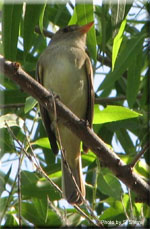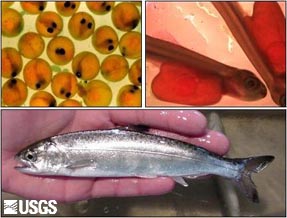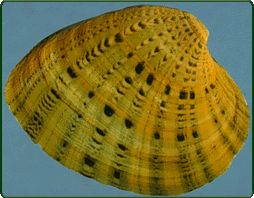- Home
- About S&T
- Taxa/Organisms
- Ecosystems
- Issues
- Methods & Tools
- Reports & Publications
- Location
- Search
November 2007 | Publisher: USGS | Format: .PDF
biology.usgs.gov — The greater sage-grouse (Centrocercus urophasianus) and the Gunnison sage-grouse (C. minimus) are species of concern because of their population declines and shrinking geographic distributions. Of continuing interest is the question of population abundance and trends. This publication answers the questions that deal with sage-grouse population, More...

2007 | Publisher: USGS | Format: URL
pubs.usgs.gov — The Southwestern Willow Flycatcher (Empidonax traillii extimus) is an endangered bird that breeds only in dense riparian habitats in six southwestern states (southern California, extreme southern Nevada, southern Utah, southwestern Colorado, Arizona, and New Mexico). This report synthesizes information on all known Southwestern Willow Flycatcher More...

Publisher: USGS | Science Center: Columbia Environmental Research Center (CERC, Columbia) | Format: URL
www.cerc.usgs.gov — The BFRS works cooperatively with team members from CERC and with faculty and graduate students of Department of Wildlife and Fisheries Sciences at Texas A&M University in research areas represented by the branch structure of the CERC including toxicology, ecology, biochemistry and physiology, environmental chemistry, ecogeography, and information More...

Publisher: USGS | Science Center: Western Fisheries Research Center (WFRC, Seattle) | Format: URL
wfrc.usgs.gov — Salmonid species in the Pacific Northwest continue to decline despite management efforts to mitigate the effects of development of the Columbia River basin and power system. Altered fish species diversity and changes in the aquatic habitat have created the need for research to determine the status, life history, and habitat requirements of at risk More...

Publisher: USGS | Science Center: Western Fisheries Research Center (WFRC, Seattle) | Format: URL
wfrc.usgs.gov — Threatened and endangered salmonids in the Pacific Northwest often use backwaters and wetlands as they migrate toward the ocean, however our understanding of the role of wetlands to juvenile salmonids is limited. The major Objective of this study was to determine whether juvenile steelhead were being tapped on the wetland during spring, and More...

Publisher: USGS | Science Center: Upper Midwest Environmental Sciences Center (UMESC, LaCrosse) | Format: URL
www.umesc.usgs.gov — Paddlefish (Polyodon spathula) have been lost from four states and Canada, and 11 of 22 states within the remaining species range now list the paddlefish as endangered, threatened, or a species of special concern. Restoration of paddlefish populations is a shared goal of many state and federal agencies. UMESC scientists, in collaboration with the More...

Publisher: USGS | Science Center: Western Fisheries Research Center (WFRC, Seattle) | Format: URL
wfrc.usgs.gov — Little is known about the importance of estuarine habitats for juvenile chinook salmon (Oncorhynchus tshawytscha), hence managers are uncertain of the appropriate levels of protection for such habitats. Research to determine the length of residence and growth of juvenile chinook salmon in the Skagit River estuary will indicate the importance of More...

Publisher: USGS | Science Center: Western Fisheries Research Center (WFRC, Seattle) | Format: URL
wfrc.usgs.gov — Fall chinook salmon (Oncorhynchus tshawytscha) in the Snake River are currently listed as threatened under the Endangered Species Act (ESA). Although fish bypass systems reduce the mortality of fish entering turbine intakes at mainstem hydroelectric dams, they are only operated during the spring, summer, and early fall during the peaks of seaward More...

Publisher: USGS | Science Center: Western Fisheries Research Center (WFRC, Seattle) | Format: URL
wfrc.usgs.gov — The objectives of this study are 1) to determine how and when juvenile suckers use near-shore habitat with emergent vegetation, 2) determine how the distribution and abundance of juvenile suckers varies between near shore and offshore areas as well as between different areas of the lake over time, 3) determine if water quality conditions affect More...

Publisher: USGS | Science Center: Western Fisheries Research Center (WFRC, Seattle) | Format: URL
wfrc.usgs.gov — Bull trout in the western United States are now listed as threatened under the Endangered Species Act. One cause of bull trout population declines is fish passage issues caused by dams and diversion structures. In order to best design or modify culverts and other fish passage structures in watersheds where bull trout are present, baseline swimming More...

Publisher: USGS | Science Center: Western Fisheries Research Center (WFRC, Seattle) | Format: URL
wfrc.usgs.gov — The California freshwater shrimp (Syncaris pacifica) is a federally listed endangered species whose distribution is seemingly restricted to low elevation perennial streams in Marin, Sonoma, and Napa counties north of San Francisco Bay, California. This study will help understand habitat requirements of shrimp by quantitatively assessing the More...

Publisher: USGS | Science Center: Upper Midwest Environmental Sciences Center (UMESC, LaCrosse) | Format: URL
www.umesc.usgs.gov — Freshwater mussels are the largest group of federally listed endangered or threatened invertebrates, and their declines may signal declining riverine health. They are a renewable resource, providing significant ecological and economic benefits to the Nation. Our study uses a landscape-level approach to assess whether the distribution of mussels More...
